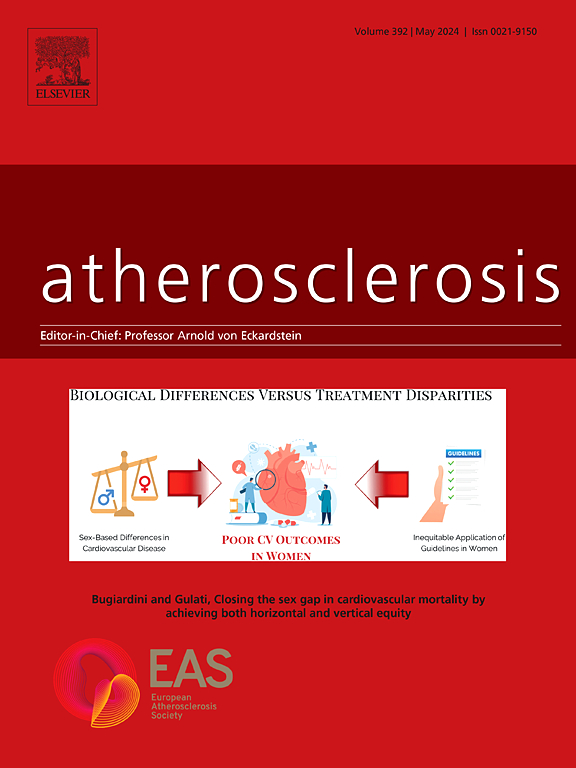Occurrence of coronary events in the absence of traditional risk factors: Understanding residual risk
IF 5.7
2区 医学
Q1 CARDIAC & CARDIOVASCULAR SYSTEMS
引用次数: 0
Abstract
Background and aims
The major predictors of future coronary heart disease (CHD) events in individuals without traditional modifiable cardiovascular risk factors (CVRFs) remain unknown. We investigated the association between circulating biomarkers, reflecting residual risk, with incident CHD in a general population, according to the presence of five CVRFs (hypertension, diabetes mellitus, hypercholesterolemia, smoking and obesity) at baseline.
Methods
Overall 212,598 CHD-free individuals from 21 European population-based cohorts were stratified by CVRF burden into three groups, having zero (n = 35,707), one (n = 68,548) or ≥2 (n = 108,343) risk factors at baseline. Five biomarkers (triglycerides (TGs), high-sensitivity C-reactive protein (hsCRP), cystatin C, N-terminal pro-B-type natriuretic peptide and high-sensitivity troponin I) were assessed in a subset with available measurements.
Results
During a median follow-up of 13.97 years, 17,499 participants developed incident CHD with 453 events occurring among individuals without CVRFs. Although increased concentrations of all biomarkers were related to incident CHD, significant risk modulation by CVRFs was seen only for TGs and, to a lesser extent, for hsCRP. The fully-adjusted sub-distribution Hazard Ratios (95 % CI) were for TGs (≥vs < 1.70 mmol/L) 1.66 (1.29–2.15) in those without CVRFs versus 1.35 (1.21–1.49)/1.14 (1.07–1.20) in those with 1 or ≥2 risk factors (pinteraction<0.01) and for hsCRP (≥vs < 2 mg/L) 1.39 (1.02–1.90) versus 1.42 (1.26–1.61) or 1.22 (1.13–1.32), respectively (pinteraction = 0.092).
Conclusion
Even in the absence of CVRFs, elevated triglycerides and hsCRP were significantly associated with an increased risk of CHD. These results highlight the importance of residual risk assessment using those biomarkers in individuals deemed metabolically healthy by conventional standards.

在没有传统危险因素的情况下冠状动脉事件的发生:了解剩余危险
背景和目的在没有传统可改变心血管危险因素(cvrf)的个体中,未来冠心病(CHD)事件的主要预测因素仍然未知。根据基线时5种cvrf(高血压、糖尿病、高胆固醇血症、吸烟和肥胖)的存在,我们调查了反映剩余风险的循环生物标志物与普通人群冠心病事件之间的关系。方法根据CVRF负担将来自21个欧洲人群的212598名无冠心病患者分为三组,基线时无(n = 35707)、1 (n = 68548)或≥2 (n = 108343)危险因素。五种生物标志物(甘油三酯(TGs),高敏C反应蛋白(hsCRP),胱抑素C, n端前b型利钠肽和高敏肌钙蛋白I)在可用的测量中进行了评估。结果在13.97年的中位随访期间,17499名参与者发生冠心病事件,其中453例事件发生在没有cvrf的个体中。尽管所有生物标志物的浓度升高都与冠心病的发生有关,但CVRFs仅在TGs和hsCRP中观察到显著的风险调节作用,在较小程度上。完全调整后的亚分布风险比(95% CI)为TGs(≥vs <;无cvrf者为1.70 mmol/L, 1.66(1.29-2.15),有1个或≥2个危险因素者为1.35 (1.21-1.49)/1.14 (1.07-1.20)(p < 0.01);2 mg/L)分别为1.39(1.02 ~ 1.90)、1.42(1.26 ~ 1.61)和1.22 (1.13 ~ 1.32)(p互作= 0.092)。结论:即使在没有cvrf的情况下,甘油三酯和hsCRP升高也与冠心病风险增加显著相关。这些结果强调了使用这些生物标志物对按传统标准认为代谢健康的个体进行剩余风险评估的重要性。
本文章由计算机程序翻译,如有差异,请以英文原文为准。
求助全文
约1分钟内获得全文
求助全文
来源期刊

Atherosclerosis
医学-外周血管病
CiteScore
9.80
自引率
3.80%
发文量
1269
审稿时长
36 days
期刊介绍:
Atherosclerosis has an open access mirror journal Atherosclerosis: X, sharing the same aims and scope, editorial team, submission system and rigorous peer review.
Atherosclerosis brings together, from all sources, papers concerned with investigation on atherosclerosis, its risk factors and clinical manifestations. Atherosclerosis covers basic and translational, clinical and population research approaches to arterial and vascular biology and disease, as well as their risk factors including: disturbances of lipid and lipoprotein metabolism, diabetes and hypertension, thrombosis, and inflammation. The Editors are interested in original or review papers dealing with the pathogenesis, environmental, genetic and epigenetic basis, diagnosis or treatment of atherosclerosis and related diseases as well as their risk factors.
 求助内容:
求助内容: 应助结果提醒方式:
应助结果提醒方式:


